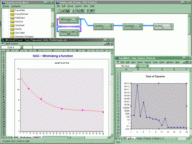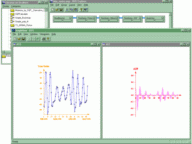STABLE: Statistics in IRIS Explorer
Besides being well known for its visualisation and numerical software,
NAG also has a range of other software products for the scientist and engineer,
including a variety of statistics software. One of these packages is called
Genstat, an advanced statistics package containing state-of-the-art routines
developed by statisticians at the Rothamsted Experimental Station in the
UK. Recently, Genstat and IRIS Explorer have been brought together in the
STABLE project, which aims to build a modern STatistical Application BuiLding
Environment.
In STABLE, statistical algorithms from Genstat will be ported to a new
environment derived from IRIS Explorer, and combined with new facilities
for visualising statistical data. The new environment will combine the
flexibility of the older command-based interface to Genstat with the ease
of use of a menu-based system. In particular, the visual programming paradigm
familiar to IRIS Explorer users will allow STABLE users to combine components
of their statistical analysis via an easy-to-use point and click interface.
Work on STABLE to date has included the design of a new IRIS Explorer
datatype to allow statistics data to be passed between modules. Because
IRIS Explorer supports the creation of user-defined datatypes, this is
straightforward to do (see below for details of an
IRIS Explorer Technical report giving a full account of this). In addition,
new modules have been written to read, process and display statistics datasets,
and the partners in the project have received training in module development
from NAG personnel.
An interesting feature of STABLE is that the platform of choice for
the project is Windows NT. Many STABLE modules have been designed to be
tightly integrated into the Windows environment, and STABLE can act as
a showcase of possibilities for other users of IRIS Explorer on this platform
(even those who are not concerned with statistics).
 For
example, because many of the STABLE users were already familiar with Microsoft
Excel, and used it to store some of their datasets, there was a call from
them for an Excel interface to STABLE. This was accomplished via OLE (Object
Linking and Embedding) Automation, which allows the creation and manipulation
of objects exposed by one application from a another application. In STABLE,
the ExcelMod module acts an automation controller and starts an instance
of Excel when it is initialised in the Map Editor. This instance of Excel
is an OLE object within the module and the module can access the properties
and methods exposed by the object. This gives the module a similar functionality
to that available in Excel macros, which allows it to open workbooks, create
worksheets, get and set cell values and so on. Figure
1 shows two instances of Excel being used in a STABLE application for
non-linear optimisation.
For
example, because many of the STABLE users were already familiar with Microsoft
Excel, and used it to store some of their datasets, there was a call from
them for an Excel interface to STABLE. This was accomplished via OLE (Object
Linking and Embedding) Automation, which allows the creation and manipulation
of objects exposed by one application from a another application. In STABLE,
the ExcelMod module acts an automation controller and starts an instance
of Excel when it is initialised in the Map Editor. This instance of Excel
is an OLE object within the module and the module can access the properties
and methods exposed by the object. This gives the module a similar functionality
to that available in Excel macros, which allows it to open workbooks, create
worksheets, get and set cell values and so on. Figure
1 shows two instances of Excel being used in a STABLE application for
non-linear optimisation.
 Another
new module developed for STABLE is GraphView, which allows for multiple
displays of y(x) data. This is written using Open Inventor for Windows
NT, which provides Inventor window classes that extend the Microsoft Foundation
Classes (MFC). The GraphView module is an MFC Multiple Document Interface
(MDI) application that uses Inventor document and view classes. Here, the
management of the size and position of the individual windows is controlled
by the MFC MDI framework and the Inventor classes control the display within
each window. The plots within the windows are Inventor scene graphs produced
using MasterSuite, which is an Inventor-based library from Template Graphics
Software. In GraphView, each component of the plot (such as axes, points,
title and so on) are individual objects, which allows the use of callback
functions when an object is selected. For example, when the user clicks
on an axis a dialog box appears allowing properties such as the axis colour
and legend to be edited. Figure 2 shows the
display of a time series and its autocorrelation function in two windows
of the GraphView module.
Another
new module developed for STABLE is GraphView, which allows for multiple
displays of y(x) data. This is written using Open Inventor for Windows
NT, which provides Inventor window classes that extend the Microsoft Foundation
Classes (MFC). The GraphView module is an MFC Multiple Document Interface
(MDI) application that uses Inventor document and view classes. Here, the
management of the size and position of the individual windows is controlled
by the MFC MDI framework and the Inventor classes control the display within
each window. The plots within the windows are Inventor scene graphs produced
using MasterSuite, which is an Inventor-based library from Template Graphics
Software. In GraphView, each component of the plot (such as axes, points,
title and so on) are individual objects, which allows the use of callback
functions when an object is selected. For example, when the user clicks
on an axis a dialog box appears allowing properties such as the axis colour
and legend to be edited. Figure 2 shows the
display of a time series and its autocorrelation function in two windows
of the GraphView module.
STABLE is funded by the European Union's Fourth Framework Programme
in association with Eurostat. Readers who are interested in keeping up
with the project will be able to find more information at the STABLE website (External).
Finally, a step-by-step account of the mechanism for
creating the user-defined IRIS Explorer datatype used in STABLE is presented
in the Technical Report "Implementing
a statistical data type in IRIS Explorer" (External), available as HTML (External) or PostScript (External)
from the IRIS Explorer
Technical Reports page (External), or as hard copy from the IRIS
Explorer Center.
Last modified: Mar 16 17:33 1999
[ Contents :
Previous Article :
Render Home :
Next Article
]
© NAG Ltd, Oxford UK. 1999
 For
example, because many of the STABLE users were already familiar with Microsoft
Excel, and used it to store some of their datasets, there was a call from
them for an Excel interface to STABLE. This was accomplished via OLE (Object
Linking and Embedding) Automation, which allows the creation and manipulation
of objects exposed by one application from a another application. In STABLE,
the ExcelMod module acts an automation controller and starts an instance
of Excel when it is initialised in the Map Editor. This instance of Excel
is an OLE object within the module and the module can access the properties
and methods exposed by the object. This gives the module a similar functionality
to that available in Excel macros, which allows it to open workbooks, create
worksheets, get and set cell values and so on. Figure
1 shows two instances of Excel being used in a STABLE application for
non-linear optimisation.
For
example, because many of the STABLE users were already familiar with Microsoft
Excel, and used it to store some of their datasets, there was a call from
them for an Excel interface to STABLE. This was accomplished via OLE (Object
Linking and Embedding) Automation, which allows the creation and manipulation
of objects exposed by one application from a another application. In STABLE,
the ExcelMod module acts an automation controller and starts an instance
of Excel when it is initialised in the Map Editor. This instance of Excel
is an OLE object within the module and the module can access the properties
and methods exposed by the object. This gives the module a similar functionality
to that available in Excel macros, which allows it to open workbooks, create
worksheets, get and set cell values and so on. Figure
1 shows two instances of Excel being used in a STABLE application for
non-linear optimisation. 